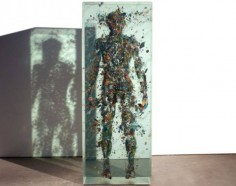DUSTIN YELLIN
Дастин Елин
source: dustinyellin
Born in California in 1975 and raised in Colorado, Dustin Yellin is a contemporary artist living in Brooklyn, New York, best-known for his sculptural paintings. Multiple glass layers, each individually embellished, create a unified intricate, three-dimensional collage. His art is notable both for its massive scale and its fantastic, dystopian themes. The work displays Yellin’s surreal romance with the detailed genius of the natural world and humankind’s dubious efforts to improve it. Yellin displays a ready willingness to experiment with forms and materials, using bizarre found objects, eccentric clippings from diverse sources, computer-generated images, acrylic, and glass.
After efforts primarily on canvas and paper, Yellin breakthrough came when he was working outdoors with natural materials embedded in resin. The effects were novel and suggestive, and Yellin realized collage could be literally expanded into another dimension.
The resulting innovative technique uses the atmosphere itself as material. With a precise and painstaking process, multi-dimensional images grow from successive planes of stacked transparencies. Initially, Yellin focused on evocative, otherworldly mutations of fundamental living things such as plants and insects, precious, alien specimens, “holograms trapped in amber.”
Soon Yellin began to make larger and larger pieces, using his display as a performance evoking an entirely believable new world. In a 2009 exhibition of this new approach, Yellin’s “Arboreum” featured a forest of eight to nine-feet-tall iridescent trees and multiple twelve-foot-long sections of a rosily glowing wildflower field.
Yellin’s work quickly graduated in complexity. His uncanny, improbably authentic portraits were built from partial worlds and extraordinary, discarded organs. Other small works presented discrete, imaginary tableaux. One scene reveals a mythical arithmetic factory with a dull tessellating assembly-line diminishing to infinity. Another is a surreal, dioramic room with a quiet door to another world guarded by a disintegrating medusa.
In 2011, Yellin began a series of life-size figures, a collection of entombed quasi-humans inspired by the two-thousand year old Qin funerary army of “Terra-cotta Warriors and Horses”. Yellin’s figures grow from thousands of antique clippings assembled in dense, tangled cellular silhouettes, as if man himself is no more than loose, disconnected images, a knotted form animated by partial truths. Other men are only ghostly wisps of vapor. These spirits sprout limbs of fog, spines of steam, humid heads. They are beings without a solid or permanent existence: transparent, dissipating, ephemeral. Still others are Siamese twins whose deformed extremities explode in animate color. All underscore disquieting realities of the human condition, revealing morality as a relative construction and ethics as a subjective prejudice. Our brief, fibrous existence and unequivocal mortality is laid bare.
“The Triptych” is Yellin’s largest and most complex work, a massive 12-ton, three-paneled epic embodying his vision of the world and consciousness. For Yellin, “the universe and the mind are shadowy places seething with dark magic, seas of boundless depth and possibility, overflowing with joy and disaster.”
In this composition of clippings, acrylic, and glass, Yellin presents a vicious, surreal spectacle. Instead of a glorious image of transcendent spirit, humankind is caught unawares by a divine reckoning. In this mythical, livid cataclysm, volcanic elemental forces smash the organized world into disconnected pieces. The preternatural scene recalls the orgiastic, aberrant violence of Bosch, with the wickedly sunny garden recast as an ominous, roiling sea. Confronted by colossal power, human technology is helpless and material progress is drowned.
In 2010, Yellin founded Pioneer Works, a social sculpture and non-profit institute for art and innovation in Red Hook. The capacious site is a venue for conceptual and creative cross-pollination, a quarter where resident artists and thinkers from diverse disciplines can interact without normative restrictions, ideally producing social change through innovative work.


